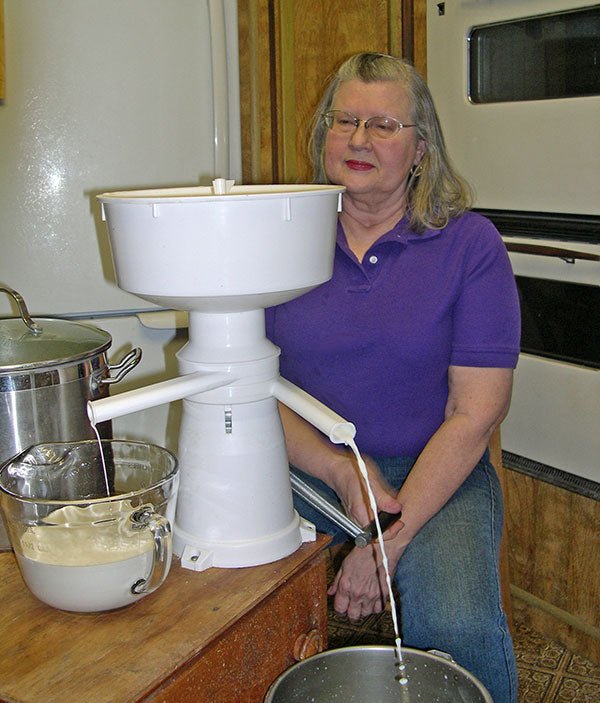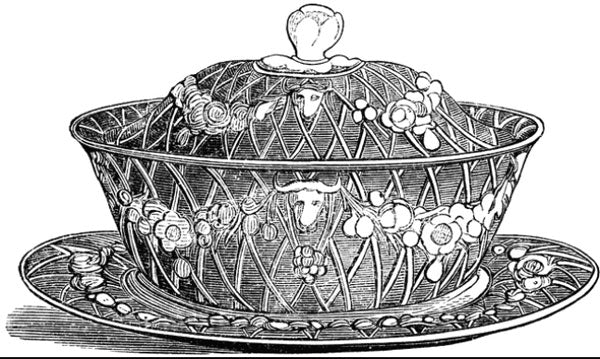
Dianne running her cream separator. Photo by Sam Miller
Dianne Miller and her husband, Sam raise purebred Nubian dairy goats on their 9 acres of land in the mountains of northeast Oregon.

Sam with Imnaha King’s Lady Jane. Photo from their Facebook page
It’s beautiful country, on the border with Idaho. Imnaha is, in fact, the the easternmost settlement in Oregon. According to Wikipedia, the population is 159, but Dianne thinks there are around 250 people in the area. She knows about a third of them.

The “business district” consists of a post office and a store/tavern.

Photo from Wikipedia
Dianne and Sam moved to Imnaha from Washington state when they retired in 2013. They had both worked in the health care field. Diane was an admitting registrar at a hospital in Renton for the last 26 years of her working life.
But, they were never “city slickers.” Dianne grew up on a farm with cows, horses and pigs. She always had her own horse. And, Sam’s family had a large garden.
In fact, 40 years ago or so, Dianne and Sam had a small farm outside La Grande, Oregon where they were both born. They sold the farm and moved to the Seattle area to find work, but they always lived on the outskirts and kept their two horses in a stable nearby.

Sam with CH River Queen at the Union County Fair some 40 years ago. Photo from the About Us section of their website
When they retired, they found their spot in Imnaha and began to pursue their dream of raising Nubians. The property came with an orchard (several varieties of apples, pear, apricot, plum, and prune trees, English and Black walnuts, and a table grape) as well as a stable for 2 horses.

Camp Creek runs near their property. There is a road between their land and the creek. Photo from the gallery page of their website

That’s their home on the right. Photo from the gallery page of their website

Goats on the hill overlooking the house. Photo from the gallery page of their website

That’s Sam on the left. Photo from the gallery page of their website

Wyandottes. Photo from Dianne’s blog
Dianne has always been a knitter and she wanted to learn to weave, so, in the beginning they had sheep along with their goats (3 ewes, their lambs and a ram). However, the sheep kept getting into the mineral mix for the goats and it was toxic for them, so, for that and a number of reasons, the sheep had to go.

2015 – Yearling Border Leicester ram, Caesar. Photo from their Facebook page
Now, they have 15 goats- 6 mature does, 7 doe kids from last spring and 2 bucks. They are milking 2 of the does right now.
The goats are fed alfalfa hay (which they love), so their diet is supplemented with grains in order to balance the calcium-phosphorus ratio.

Photo from their August 18th Facebook page where the caption reads, “Kids on deck!”

Kingfisher eating a tree. Photo from the gallery page of their website

Silver Belle gave 3600 pounds of milk last year! Photo from their Facebook page
Dianne bottle feeds the kids and she weans them at 5 months, since she has plenty of excess milk around. She used to sell her milk, but there were issues with the customers which she explains in an interesting blog article- Why I No Longer Sell Milk).
So, she began making cheese and butter in 2014. By the end of 2015, she had a well stocked cave:

She uses clear cheese wax. Photo from Dianne’s blog

Photo from Dianne’s blog
Her husband built shelves for her cheese in her feed and tack room, because it’s insulated and it maintains a temperature of 55-60F. An air filter helped with the dust, but it was still too dusty, so she moved her cave to the other end of the building and began using a wire rack.
Her cave now consists of ripening mats on the wire rack and this is working perfectly.

Photo by Sam Miller
She now makes butter once or twice/week and cheese several times a week after the kids are weaned and there is excess milk. She makes fresh cheese (chevre, mozzarella and ricotta) and hard cheese (parmesan, farmhouse cheddar and monterey jack). She prefers dipping her cheeses in wax, rather than brushing them. She dips them twice.

Photo from Dianne’s blog
Dianne also makes her own butter which she estimates saves her $12-$20 per week. For this, she bought a hand crank cream separator from Amazon. (It is harder to separate the cream in goat’s milk because the fat globules are smaller.)

Kubik Rubik Cream Separator, listed on Amazon new for $155.48 (click here). Photo by Sam Miller
She usually gets 1 ½-2 quarts of cream from 6 gallons of her goat’s milk.
Dianne’s Process for Making Butter:
She chills her cream overnight, then uses her Gem Dandy electric butter churn to make the butter.

Goat cream ready to be churned. Photo by Sam Miller

She found this electric butter churn on eBay and it has served her well. Photo from Dianne’s blog

Draining in butter muslin. Photo by Sam Miller

Squeezing out the buttermilk. Photo by Sam Miller

Butter on left, buttermilk on right. Photo from Dianne’s blog
She gets 2.9-3 pounds of butter to which she adds 1/2 teaspoon of salt.

Butter made from goat’s milk is white. Photo from Dianne’s blog
She then wraps a loaf pan with waxed paper, spreads the butter into it, cools it down in the fridge and cuts it into quarters. She usually freezes some of it.

Loaf pan ready for butter. Photo by Sam Miller

Spreading butter in the loaf pan. Photo by Sam Miller

Ready for freezing. Photo from Dianne’s blog
Dianne is a “do-it-yourselfer.” In addition to making cheese and butter, she knits and makes her own Italian sausage. She uses her Kitchen Aid mixer with the food grinder attachment to convert pork shoulder to sausage. We’ll be doing an article about that soon, so, stay tuned!
In her blog, she is willing to break everything down to the most concise details. This has resulted in a blog with lots of helpful advice about raising dairy goats (click here). Articles like these are invaluable: Basic Needs for Owning Dairy Goats (May 10, 2016), New Owner’s Goat Buying Guide (January 17, 2016) Kidding Season-Set Your Does Up for Success (October 16, 2015), Breeding Goals and Programs (October 5, 2015), Some Lessons Learned (August 10, 2015) and How to Get Really Good Goat’s Milk (May 3, 2015).
When Dianne was in college, she took ceramic courses from Tom Diamond and he taught her the value of learning how things are made. He taught her that you don’t really understand or appreciate something unless you know the process involved to produce it.
Dianne believes that people, in general, can do a lot more than they think they can. Making cheese, for example, can be intimidating, but anyone can do it. A person just needs to be willing to learn. There are many books available, or there are videos online for visual learners. It’s important to invest in quality equipment, but it’s not necessary to spend a lot of money – you can often find used equipment or even make your own. Her advice for beginners – go for it!














































































































































